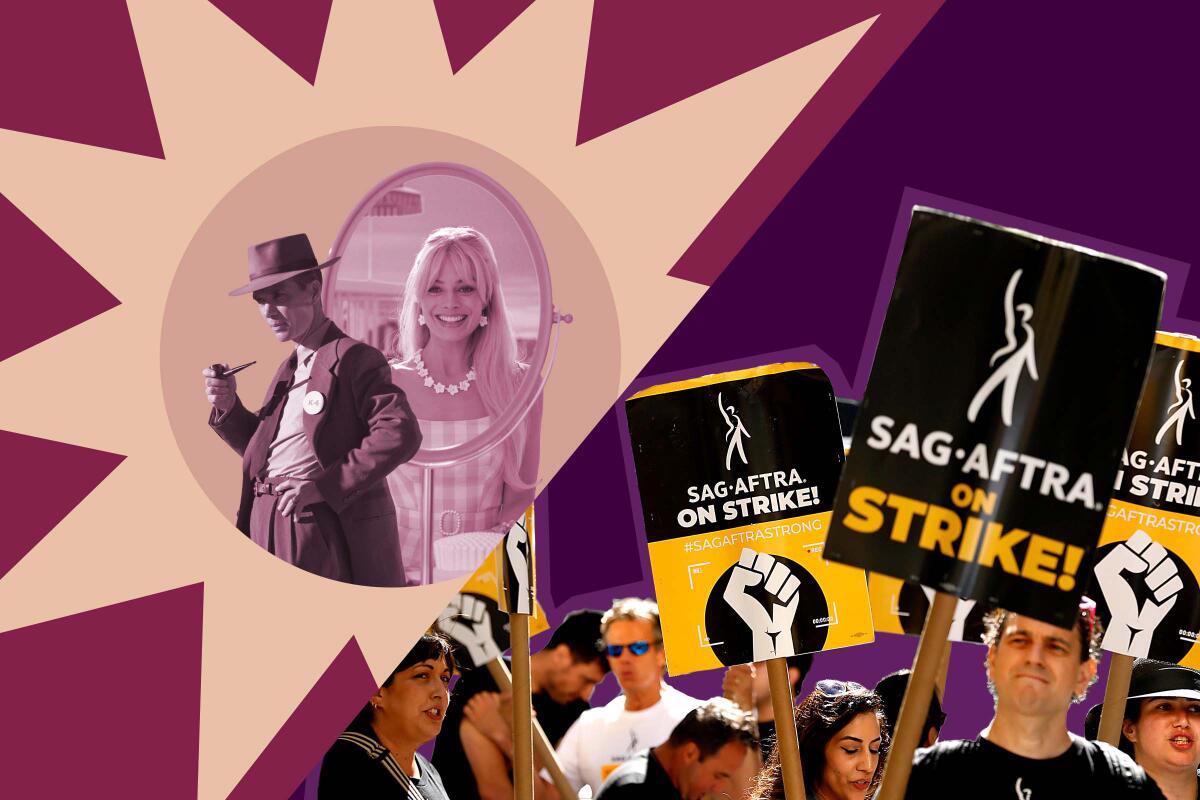Hollywood’s disjointed summer: $4 billion in box office and a never-ending strike crisis

- Share via
Welcome to The Wide Shot, a newsletter about the business of entertainment. Sign up here to get it in your inbox.
For Hollywood, it was the ultimate good news, bad news summer.
For the first time since the COVID-19 pandemic shuttered theaters more than three years ago, the summer box office reached the $4-billion box office milestone in the U.S. and Canada.
But any optimism the business can squeeze from this summer’s payday is undercut by dread of the endless writers’ and actors’ strikes, the former of which is now in its fourth month.
First, the fun stuff.
Moviegoing surged, just not for the reasons anyone expected. “Barbie” and “Oppenheimer” created an alchemical zeitgeist phenomenon that studios will surely try and fail to replicate in the future (You liked “Barbenheimer?” Here comes “Saw Patrol!”).
Some of the big-budget franchises that were supposed to represent the studios’ safe bets turned out not to be so safe, DC’s “The Flash” flaming out being an illustrative example. And what algorithm would have anticipated that Angel Studios’ “Sound of Freedom,” an independently released movie about child trafficking starring Jim Caviezel, would out-gross Harrison Ford in an “Indiana Jones” sequel or post-”Maverick” Tom Cruise in a well-reviewed “Mission: Impossible” movie (domestically, at least)?
Other big films did exactly what any box office forecaster would’ve predicted, as with James Gunn’s “Guardians of the Galaxy Vol. 3” and the latest from the minds of Phil Lord and Chris Miller, “Spider-Man: Across the Spider-Verse,” both of which earned widespread praise for their high quality. And whereas the Labor Day weekend is typically a dead zone, Sony’s “The Equalizer 3” ended the season with a strong four-day opening of $42 million. Total summer sales were up 19% from the same time last year, according to Comscore.
Success sprung from singular artists at the top of their game pursuing eccentric ideas. Failure came from following prepackaged formulas based on what worked last time. If there’s a lesson to be learned from Hollywood’s disjointed summer season, it’s this, in the words of Paul Dergarabedian, Comscore’s senior media analyst and longtime box office expert: “Don’t underestimate the audience.”
“We have hung our hat on the fact that the summer is built on the backs of franchises — well known, historic brands,” Dergarabedian told me last week. “I don’t know that today’s audiences care so much about the legacy as much as they care about the movie.”
Now what?
A $4-billion summer does not indicate a full return to health for the theatrical film industry.
The pre-pandemic summers of 2019 ($4.35 billion) and 2018 ($4.43 billion) were bigger, fueled by “The Lion King” and “Incredibles 2,” respectively.
But achieving this summer benchmark is symbolically important for the nation’s beleaguered theater circuits. The season — which, on Hollywood’s calendar, runs from the first Friday in May through Labor Day — typically represents about 40% of the domestic annual total.
It’s the fall season and beyond that have become beset by uncertainty, thanks to the industry’s long labor quagmire.
Warner Bros. moving “Dune: Part Two” from November to March, thanks to the SAG-AFTRA walkout derailing its star-driven marketing plans, will sap some momentum. Similarly, Sony moved “Kraven the Hunter,” a “Ghostbusters” sequel and “Spider-Man: Beyond the Spider-Verse.” MGM/Amazon pushed “Challengers” to April.
However, Apple has opted to skip its limited rollout for Martin Scorsese’s “Killers of the Flower Moon,” in favor of going straight to a wide theatrical release in October (with help from its distribution partner, Paramount Pictures).
Beyond the studios’ franchise titles (“The Marvels” and “Wonka,” all still on the calendar), there is, knock on wood, a promising selection of original, ambitious movies planned for fall and beyond, including Ridley Scott’s “Napoleon,” Alexander Payne’s “The Holdovers,” Yorgos Lanthimos’ “Poor Things” and Michael Mann’s “Ferrari.” Netflix is giving David Fincher’s “The Killer” and Bradley Cooper’s “Maestro” limited theatrical runs before they hit the streaming service.
Better yet, Taylormania is poised to boost theaters, with a concert film based on Taylor Swift’s massive Eras tour coming in October. The film has generated impressive presales, and competitors, such as Blumhouse and Universal’s “The Exorcist: Believer,” are getting out of the way.
Analysts forecast that U.S.-Canada ticket sales will end up at about $9.5 billion in grosses this year, though that’s based on educated guesswork. In the years before COVID-19, movies regularly generated around $11 billion in annual ticketing revenue, and tickets are always getting more expensive. Attendance was gradually trending downward before 2020.
All the more reason why the studios and the guilds need to find a way to end the strikes, which continue to wreak widespread economic hardship.
A time to deal
As California State Treasurer Fiona Ma said in her letters to studio chiefs last week, 15,000 members of the International Brotherhood of Teamsters have been out of work for months. About 20% of L.A.-area income comes from the entertainment or adjacent industries and more than 700,000 Californians are employed in entertainment jobs, to say nothing of the damage to New York and other production hubs. If the work stoppages go on for much longer, working people will basically be forced to exit the business.
For this to end, there must be compromise. But that still seems a long way off. As my colleagues Meg James and Wendy Lee wrote, labor relations of late have been characterized by a high degree of frustration, fear and distrust.
At this moment, it seems that the WGA has never been more powerful.
Sure, media companies can make money from the content they have stored on the shelf, but that well will start to run dry with their productions on hold. Reports of infighting among the chief executives do not bode well for a swift resolution. Whether the strikes end in the fall, January or somewhere in between — or beyond — is anyone’s guess.
That said, as the truism goes, no one gets everything they want from a labor negotiation. The urgency to complete a deal could accelerate if out-of-work below-the-line crew members start to agitate loudly for both sides to give ground.
To commemorate Labor Day, leaders from the WGA and SAG-AFTRA sent messages to members emphasizing union solidarity. WGA negotiating committee co-chair Chris Keyser, in a Monday video, acknowledged the suffering of crew, craftspeople and drivers who are not on strike but are unable to perform their trades.
“We will not forget what you’ve done for us,” said Keyser. “What we promise you is this: As you have stood with us, we will stand with you one day when it is your turn. That is how labor gets its due.”
The divide between the WGA and the Alliance of Motion Picture and Television Producers has been well documented. The purely economic issues — minimum pay, residuals, pension and healthcare contributions — seem normal and surmountable, industry observers say. The AMPTP said its offer of a 13% compounded three-year wage increase represents the biggest guild pay bump in 35 years. Writers and their allies have said this ignores economic realities, including inflation. But sensible people can figure this out.
The real challenges are the ones that speak to the changes streaming has brought upon the business.
With shorter TV seasons becoming the norm, the WGA is seeking minimum staffing levels and guaranteed length of employment. Writers also say they want a system of compensation that rewards them in success of their shows on streaming services. For that to happen, there needs to be some transparency with streaming data, which studios have long been reluctant to disclose in a meaningful way.
The studios’ Aug. 11 proposal, which the AMPTP summarized in a six-page press release once discussions faltered, gave some ground on these issues that were once seen as non-starters.
For example: The AMPTP offer included a minimum 10 weeks of employment for writers hired in development rooms. For high-budget streaming and pay-television shows, the studios offered to let showrunners select at least two writers to be employed for at least 20 consecutive weeks, but not exceeding the duration of the writers room.
The AMPTP budged a bit on the transparency sticking point, offering to disclose viewership data through quarterly confidential reports to WGA representatives. That, in the studios’ words, would “enable the WGA to develop proposals” to restructure the current residual model for subscription-based streaming services in the future.
The WGA called the AMPTP proposals “neither nothing, nor nearly enough,” arguing that its offers were littered with loopholes rendering them toothless, “in the typical AMPTP mode of seeming to give while limiting the actual gains.”
The WGA negotiators told members that it responded to the studio alliance with its own counterproposal on Aug. 15, which was followed by more meetings and, eventually, an Aug. 22 session in which the company leaders tried to browbeat the writers’ reps. Each side insists that the ball is in the other’s court.
But apart from the rhetoric from the studios and the unions, which escalated in recent weeks, are these differences so difficult to overcome? In a world in which humans have figured out how to split the atom, can’t studios, writers and actors figure out a way to avoid a path to mutually assured destruction?
The stakes for the future of the entertainment business couldn’t be clearer. Right now, Hollywood is blowing it.
Stuff we wrote
— These film school grads ditched studio jobs for YouTube and TikTok. How’s that going? TikTok, YouTube and other social media platforms have democratized who gets to be an entertainer. So why do some web creators still go the old-school route and attend film or acting school?
— Disney pulls ABC, ESPN, FX and other channels from Charter Spectrum service. The carriage fee dispute means that millions of Spectrum customers will go without “Jeopardy!” U.S. Open tennis coverage and football on ESPN. The cutoff coincided with the start of a highly anticipated college football game between Utah and Florida.
— Can ESPN survive while cable TV dies? Long known as the “Worldwide Leader in Sports,” the Disney-owned cable network is grappling with cord-cutting, rising rights fees and skepticism from Wall Street.
— ‘Power Rangers’ at 30: How a show with Japanese monsters and teen drama captured a generation. A deep dive on the history of Haim Saban’s longrunning kids’ franchise.
— Forget Harry Styles. Riot Games is one of L.A.’s biggest stars headlining the Kia Forum. Esports for both the first-person shooter “Valorant” and the popular multiplayer online battle arena game “League of Legends” are key to engaging with players and helping “build the future of sport” at Riot Games.
— Fox Business Network and Univision will carry the next GOP presidential debate. Fox’s Stuart Varney and Univision’s Ilia Calderón will moderate the Sept. 27 event, but the network’s star anchor Maria Bartiromo won’t be there.
Finally ...
Jeff Rosenstock is punk rock. The famously independent musician’s latest album, “Hellmode,” showcases his wide stylistic range. He can be rowdy and anthemic, as on the shout-chorus single “Liked U Better,” but also gentle, with the acoustic “Healmode.” The lyrics are earnest and poignant, but it completely works on me.
For something completely different: The best death metal album of the year, for those keeping track, just might be the latest from Philadelphia’s prog-influenced outfit Horrendous.
Lastly, rest in peace to Steve Harwell, the lead singer of Smash Mouth, a band that supplied much of the soundtrack for my youth. Here’s “Walking on the Sun,” an alt-rock radio classic that I will stand by to this day.
The Wide Shot is going to Sundance!
We’re sending daily dispatches from Park City throughout the festival’s first weekend. Sign up here for all things Sundance, plus a regular diet of news, analysis and insights on the business of Hollywood, from streaming wars to production.
You may occasionally receive promotional content from the Los Angeles Times.




